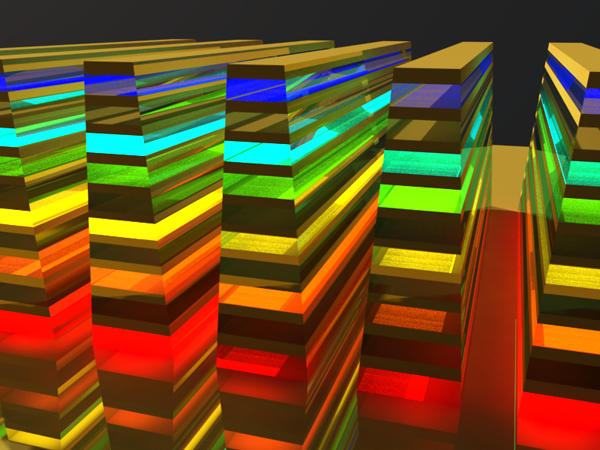"How do you hold a moon beam in your hand?" mother superior sang in the "Sound of Music."
Catching light or a rainbow has always been a dream of artists. It's also the aspiration of engineers working in photonics.
By creating a material that slows light and traps multi-wavelengths in a broadband (or rainbow), I and a team of graduate students at the University at Buffalo (UB) have developed a more efficient way to catch rainbows. The advancement, which we are calling a "hyperbolic metamaterial waveguide," could lead to breakthroughs in solar energy, stealth technology used by the military and other areas of research.
The research is described in "Rainbow Trapping in Hyperbolic Metamaterial Waveguide," a paper published Feb. 14 in the online journal Scientific Reports.
The waveguide is essentially an advanced microchip comprised of alternate ultra-thin films of metal and semiconductors and/or insulators. It halts and ultimately absorbs each frequency of light, at slightly different places in a vertical direction (see the attached figure), to catch a "rainbow" of wavelengths.

Electromagnetic absorbers have been studied for many years, especially for military radar systems. Right now, researchers are developing compact light absorbers based on optically thick semiconductors or carbon nanotubes. However, it is still challenging to realize the perfect absorber in ultra-thin films with tunable absorption band.
We have created a device - the hyperbolic metamaterial waveguide - that will slow light and therefore allow much more efficient absorption, which will address the long existing challenge.
Light is made of photons that, because they move extremely fast (i.e., at the speed of light), are difficult to tame. If the photons can be slowed down, a lot of exciting applications are possible.
For instance, the slowed light will have more time to interact with material for enhanced nonlinear optics and energy harvesting. It can also be used in future optical computing systems as an optical buffer, which would slow down or trap light temporally when the computer is busy. This will help improve the signal management for higher computing speed and capabilities.
In conventional attempts to slow light, researchers used cryogenic atomic gases (so called Bose-Einstein condensate). But because cryogenic gases are very cold - roughly 240 degrees below zero Fahrenheit - they are difficult to work with outside a laboratory. As a result, it is problematic to develop practical applications using the slowed light inside cryogenic gases.
Before joining UB, I and other researchers in Dr. Filbert Bartoli's group helped pioneer a way to slow light without cryogenic gases at Lehigh University. We made nano-scale-sized grooves in metallic surfaces at different depths and periods, a process that altered the optical properties of the metal surface. This was reported in the journals Physical Review Letters, Proceedings of National Academy of Sciences and Applied Physics Letters.
The intriguing phenomenon is that the nano-patterned surface can slow light under room temperature. While the grooves worked, they had limitations. For example, the energy of the incident light cannot be transferred onto the metal surface efficiently, which hampered its use for practical applications.
The hyperbolic metamaterial waveguide solves that problem because it is a large area of patterned film that can collect the incident light efficiently. It is referred to as an artificial medium with subwavelength features whose frequency surface is hyperboloid, which allows it to capture a wide range of wavelengths in different frequencies including visible, near-infrared, mid-infrared, terahertz and microwaves.
It could lead to advancements in an array of fields.
For example, in electronics there is a phenomenon known as crosstalk, in which a signal transmitted on one circuit or channel creates an undesired effect in another circuit or channel. The on-chip absorber could potentially prevent this.
The on-chip absorber may also be applied to solar panels and other energy-harvesting devices. It could be especially useful in mid-infrared spectral regions as thermal absorber for devices that recycle heat after sundown.
Technology such as the Stealth bomber involves materials that make planes, ships and other devices invisible to radar, infrared, sonar and other detection methods. Because the on-chip absorber has the potential to absorb different wavelengths at a multitude of frequencies, it could be useful as a stealth coating material. By engineering the geometric parameters of the on-chip waveguide array, the absorption profile of the surface can be engineered to mimic other materials, which is extremely promising for camouflage applications.
While a leprechaun hides his pot of gold at the end of the rainbow, we may catch the rainbow and open the leprechaun's treasure of science and engineering.
Additional authors of the paper include Haifeng Hu, Dengxin Ji, Xie Zeng and Kai Liu, all PhD candidates in UB's Department of Electrical Engineering. The work was sponsored by the National Science Foundation and UB's electrical engineering department.
Qiaoqiang Gan, PhD, is an assistant professor of electrical engineering at the University at Buffalo. His group is exploring fundamentally new nanophotonic structures and developing novel applications for energy and sensing.